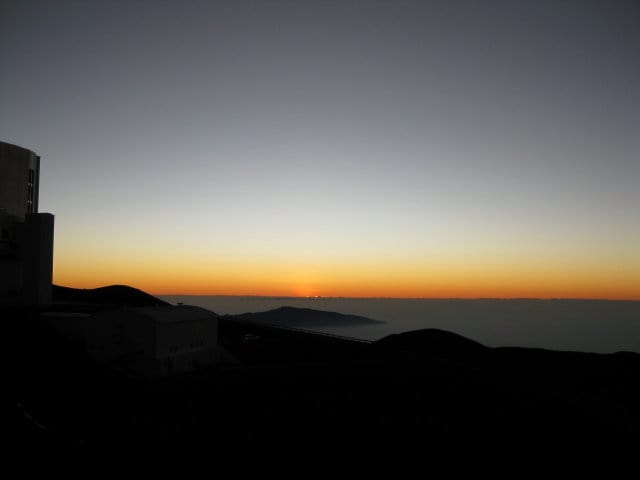Monday, Day 17
We arrive early morning in Hilo and are glad to be on land after so long at sea. In the late morning a group of us go with the knowledgeable and redoubtable Lee and Tina Riedinger to visit Mauna Kea and the world famous observatories at its peak. On the way, the hulking bulk of the still active volcano, Kilauea, becomes increasingly apparent as a fantastically, impossibly enormous shape that is difficult to distinguish from cloud formations through all the haze of sulfur dioxide emissions. While Kilauea spouts fumes and slow-moving lava, Mauna Kea often features a cap of snow. On our visit, there are only wisps of snow on the ground but, as always, it is very cold. (Postcards feature a particularly striking view of the snow-capped old volcano from the distant white and black sand beaches of Hilo.)

The photo here shows what the immense active volcano of Kilauea looks like from the summit of Mauna Kea. The surface on Mauna Kea, beginning at around 9,000 feet, is a real moonscape.

Rare silversword plants thrive amid grasses near the lodgings of the astronomers who work at the observatory (4 days and 3 days off) about half way up the mountain.
There are excellent informational displays inside the small visitor center. A couple of small groups within our party are fortunate to tour inside the observatories. Four girls and myself are inside Keck 2 while it revolves to put the telescopes into position for the evening’s observations. The engineering is amazing.

This photo features one of the observatory technicians in Keck 2, hooked to a bottle of oxygen due the altitude.
The peak is 16,000 feet. I’m fine going up and while at the top but I get altitude sickness, along with 5 other girls, at about 9,000 feet late that night on the way down. So my attention to the evening stargazing activities is diverted. The symptoms are a pounding headache and increasing nausea all the way home. The tour guides give us oxygen from the bottles they have at ready for the purpose but it doesn’t help much. We are all grateful to make it safely to our cabin bathrooms before we lose what we’ve eaten that day. After which we feel just fine. But at 16,000 feet and 6 hours away from the ship, that seems like a long way away.
Exhausted and cold, it seems a good idea to lay down in the waning sun awaiting the sunset, which no one wants to miss, no matter how cold it gets. The reward is amazing.
Regardless, the visit is worth every bit of trouble. There is nothing like it in the world.



